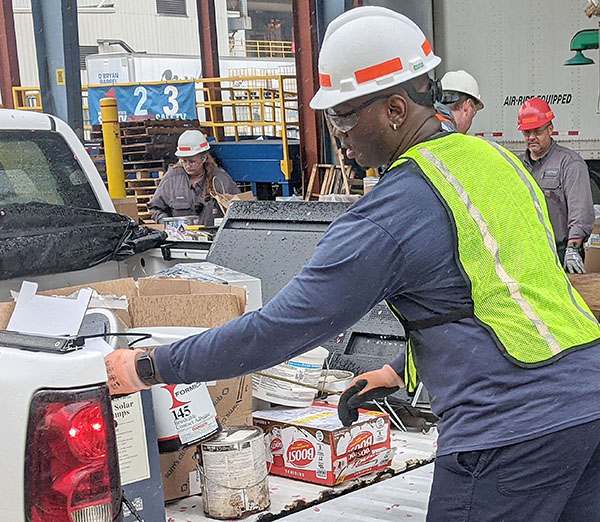A common inquiry we receive concerns proper management of spent mercury-containing lightbulbs or “lamps” and how lamp crushers can be used in the waste management process.
Mercury is a hazardous material. All fluorescent lamps and compact fluorescent lamps (CFLs) contain elemental liquid mercury, as do high-intensity discharge (HID) lamps such as mercury vapor, metal halide, and high-pressure sodium lamps. When a lamp is broken, the mercury vaporizes into an invisible, odorless, and tasteless vapor. Inhaling mercury vapor is extremely dangerous to human health. If released to the environment, the mercury can be transformed to methylmercury, which is more toxic than elemental mercury and which bioaccumulates within food chains.
Normal handling of intact lamps presents a very low risk of mercury exposure. Repeated exposure to broken lamps or a one-time exposure to a large number of broken lamps increases the risk. The key is to protect lamps from accidental breakage and properly manage spent lamps.
Regulations
Since January of 2000, the USEPA has allowed spent mercury lamps to be managed as universal waste. A lamp generator can be a Small Quantity Handler of Universal Waste (SQHUW) or a Large Quantity Handler of Universal Waste (LQHUW) depending on the number of spent lamps accumulated at one time. See www.ecfr.gov for the federal universal waste handler requirements in 40 CFR 273 Subparts B and C. Recycling of mercury lamps is strongly encouraged. If a facility does not choose to manage their mercury lamps as universal waste, they must then be disposed of as a full RCRA hazardous waste.
In addition, some states require broken lamps to be handled according to full RCRA hazardous waste regulations. Be sure to check with your state’s environmental agency for up-to-date waste handling requirements. The National Electrical Manufacturers Association (NEMA) makes available an interactive map with links to state environmental agencies and fact sheets. You can access the map at www.lamprecycle.org. A USEPA table of links to state universal waste regulations is also available at www.epa.gov.
Sections 273.16 and 273.36 of the Universal Waste Rule discuss the general employee training requirements for small and large quantity handlers of universal waste. Specifically for mercury lamp management, the Association of Lighting and Mercury Recyclers (ALMR), with support from USEPA, developed an easy-to-use “Training Module (1-hour version) for Generators and Handlers of Fluorescent and Mercury-Containing Lamps (and Ballasts).” The document is available for download at http://almr.org/resources.html.
Lamp Crushers
Crushing is the intentional, controlled breaking of mercury-containing lamps into an appropriate storage container. Crushing itself is not recycling, but it can be part of a facility’s lamp recycling program. Crushing lamps can have several benefits: reduced risk of accidental lamp breakage during packaging and shipping of whole spent lamps; reduced handling time by eliminating the need to package and ship whole lamps; reduced storage space requirements.
A drum-top crusher is a mechanical device that is mounted on the top of a 55-gallon drum. The lamps are fed into the crusher and the crushed components are stored in the drum until ready for pickup for recycling or disposal. A 55-gallon drum typically can hold 1,000 or more crushed 4-foot lamps or the equivalent amount of other lamp types.
The lamp components are not separated during crushing, so the drum will contain mercury, phosphor powder, glass, and metals. The mercury will tend to evaporate, so an activated carbon filter is used to capture mercury vapor before it can be released to the ambient atmosphere. Dust filters and HEPA filters are also used to prevent particulate release.
Proper filter disposal depends on the specific type of crusher you use. The technical specifications for each type of crusher being considered or used should be carefully studied and understood to ensure filters are installed, checked, changed, and disposed of properly.
Monitoring and PPE
Areas in which a lamp crusher is used should be monitored for mercury vapor and mercury-containing particulates. The monitoring can be accomplished using various methods such as wipe sampling and air sampling.
At a minimum, Level D PPE should be used by employees operating the crusher or otherwise working in the immediate area. Higher levels of PPE may be required depending on the specifications of the specific crusher and area monitoring results.
Learn more about our Hazardous Waste Services
More News From Heritage
-
10/14/24
Heritage Environmental Services Announces Timothy Thomas as Chief Operating Officer
Heritage Environmental Services (“HES”), an EQT Infrastructure portfolio company, announced today that Timothy Thomas will join the organization as Ch
-
10/1/24
Heritage Environmental Services Complete Acquisition of EBV from General Dynamics
Heritage Environmental Services, an EQT Infrastructure portfolio company, has completed the acquisition of EBV from General Dynamics.
-
7/31/24
PFAS Regulations: Is 6 the Magic Number?
Learn more about the current and proposed regulation for PFAS and what they mean from our Chief Sustainability and Innovation Officer, Angie Martin.
-
6/27/24
Heritage Environmental Services to Acquire EBV from General Dynamics
Heritage Environmental Servicess, an EQT Infrastructure portfolio company, will acquire EBV from General Dynamics
-
6/13/24
Meet The Facilities – East Liverpool
An inside look at our incineration facility located in East Liverpool, OH
-
5/24/24
Habitat for Humanity 2024
Heritage hosted our 14th annual Habitat for Humanity build this month, partnering with over 50 employees from various THG companies.
-
5/6/24
Date set for the household hazardous waste collection in East Liverpool, Ohio
-
3/12/24
Equal Pay Day – Spotlighting Our Female Drivers








